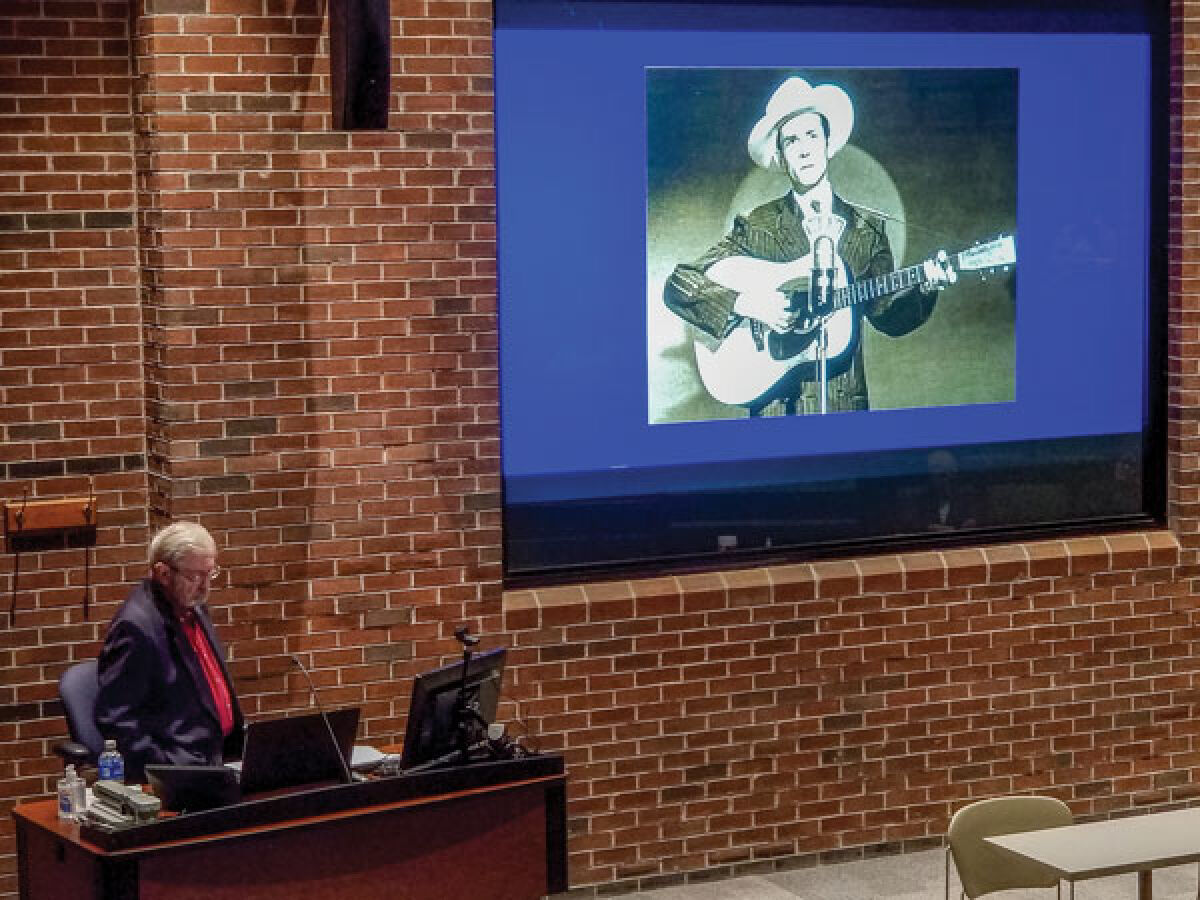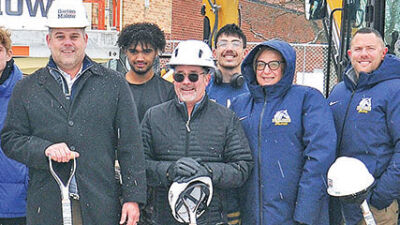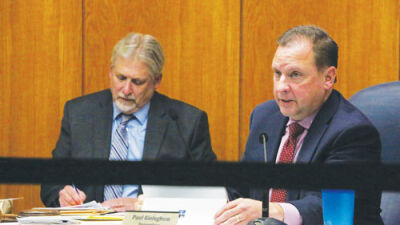CLINTON TOWNSHIP — Nostalgia filled Assembly Hall at Macomb Community College’s University Center May 17 when music historian Stu Johnson brought his “Music of the Postwar Years: 1946-1955” to class.
Through a PowerPoint presentation, Johnson played several songs from the 1940s and 1950s and told a story behind each one. His program, which included black-and-white photos, was one of many classes offered this spring in the Macomb Organization for Retiree Enrichment, or MORE, program.
“The songs I’ve chosen were all at or near the top of the charts,” Johnson said.
Some had vocals while others were instrumentals. Audience members heard “Cherry Pink and Apple Blossom White,” by Perez Prado; “Ole Buttermilk Sky,” by Hoagy Carmichael; “Scrapple from the Apple,” by Charlie Parker; and much more.
Johnson introduced many musicians, too, including Duke Ellington, the Harmonicats, Count Basie and Percy Faith. As the tunes played, a few audience members tapped their feet to the beat. Johnson has collected music for decades, researching everyone from Nat King Cole to the Andrews Sisters. The Royal Oak resident loves to share with others what he has learned.
Last Tuesday, he talked about how music changed after World War II ended in 1945. The big band, swing and jazz artists, sought after for years, began to lose their listeners. While some still played for small crowds and at high school dances, several disbanded. And with that, other genres of music began to emerge, including pop, modern jazz, country and western, and rhythm and blues.
“All of them were vying for attention and time. Bebop had pretty much taken over the jazz world. Swing became pop music, which brings us here today,” Johnson said. “The service men and women were coming home. They were looking for something different. They had had enough of the last 10 years and all the fighting and wanted something different than what they had experienced.”
How consumers listened to their favorite artists also impacted music.
“Up until the late 1940s, 78 (rpm recordings) was the medium used for jazz, big band,” Johnson pointed out. “With the addition of the 33 1/3 vinyl record, 20 minutes of music or more could be recorded on one side.”
Early in the presentation, Johnson played jazz singer Sarah Vaughan’s version of “Tenderly.” He also gave a brief overview of “I’ve Got My Love To Keep Me Warm,” by Les Brown.
“It had been recorded as a Christmas album and sold over 1 million copies,” Johnson said. “Some say it was the last big band top hit ever recorded.”
When touching upon country music, it’s noted that Hank Williams Sr. performing “I’m So Lonesome I Could Cry” pulled at the heartstrings of two rock ‘n’ roll icons: Elvis Presley and Bob Dylan.
“Elvis Presley, before he sang this at his ‘Aloha From Hawaii’ concert, said this is the saddest song he’s ever heard,” Johnson said.
Johnson shared a personal recollection of band leader Russ Morgan’s “Cruising Down the River.”
“One of the few distinct memories I have is of my graduating seventh grade class taking our class trip from my hometown in Wisconsin to Madison, about 40 miles,” he said. “We sang on the school bus, but the only song I vividly remember singing is ‘Cruising Down the River.’ I hadn’t heard this song in years until I started putting this presentation together.”
In addition, “The Tennessee Waltz” has not been forgotten.
“It was the last song to sell 1 million copies of sheet music,” Johnson said. “Up until 1974 it was the biggest selling song in Japan.”
‘The sock hop had replaced the ballroom’
Johnson’s 90-minute presentation ended when Bill Haley and the Comets came on the scene with “Rock Around the Clock.”
“This and ‘Shake, Rattle and Roll’ ushered in the rock ‘n’ roll era,” Johnson said. “What made music exceptional were the kids. If they could dance to it, it was popular. The sock hop had replaced the ballroom.”
MORE is a lifelong learning program of the Cultural Affairs and Community Engagement Department at Macomb Community College. The non-credit classes cover a wide variety of subjects and topics and are presented by volunteer guest faculty.
Macomb County resident Marlene Klebba enjoyed the presentation.
“I love the music of the big band. I like Patti Page. I love Tony Bennett. You can’t go wrong with Tony Bennett,” she said.
Deborah Remer, of Shelby Township, has been a MORE presenter and also has attended other programs by Johnson.
“I have always loved his programs,” she said, adding that most of the songs he played were released before she was born, although she still recognized many of them. “My mom and dad must have played them when I was little.”
Also present was Sharon O’Brien. She and Johnson are a couple, and O’Brien attends all of his events.
“I love jazz just as much as he does. They are all from our time growing up,” she said. “He has taken us down memory lane.”
O’Brien’s favorite song in the program was “How High the Moon Is,” which many artists recorded, including Les Paul and Mary Ford.
Johnson presents other programs related to music history, including a look back at the 1960s. He will have some events at the Royal Oak Public Library later this year.
To reach Stu Johnson, email stujohnson@wowway.com or call (248) 549-2969.
For more information about MORE, go to LorenzoCulturalCenter.com/more or email MORE@Macomb.edu.
 Publication select ▼
Publication select ▼





















